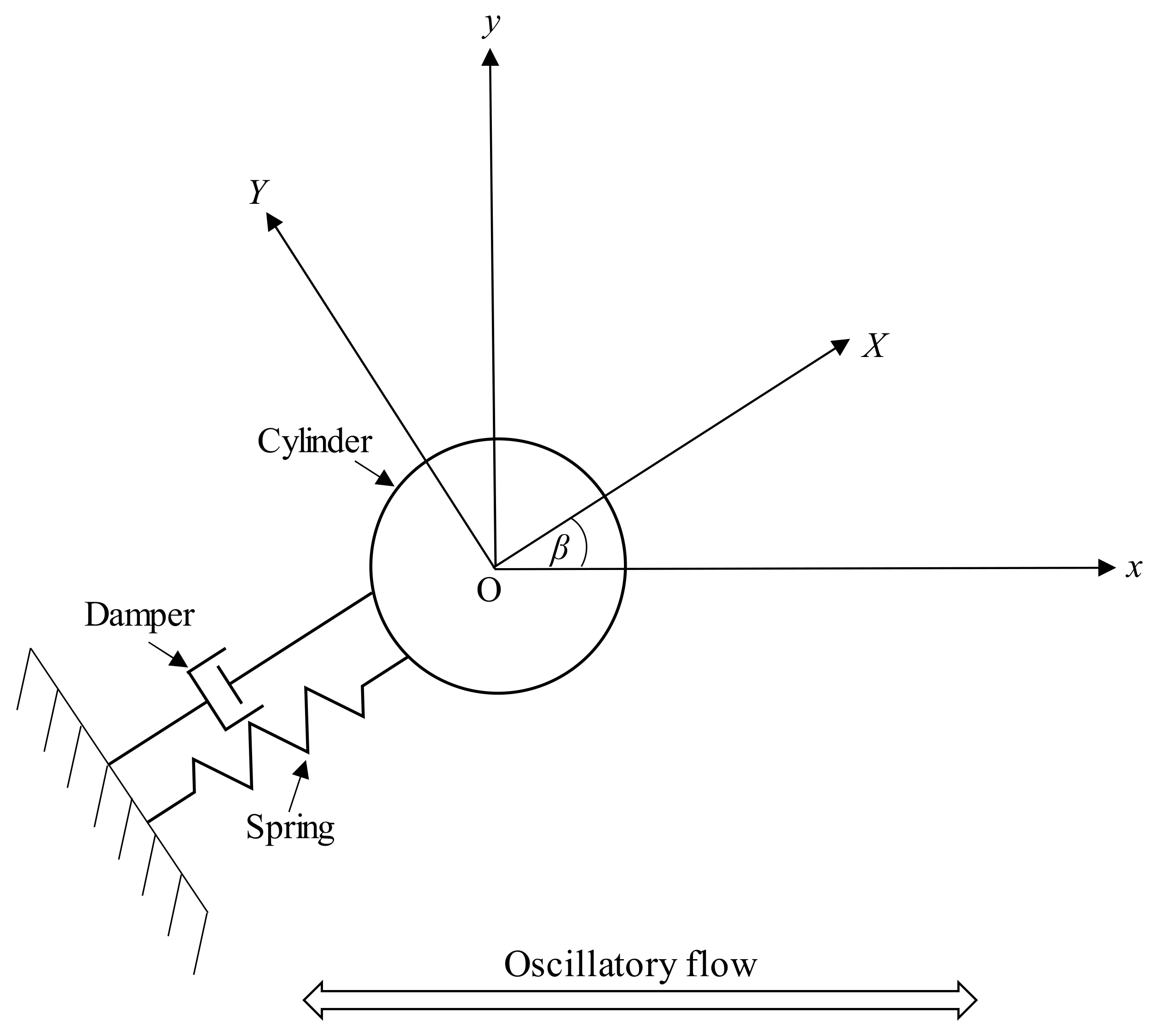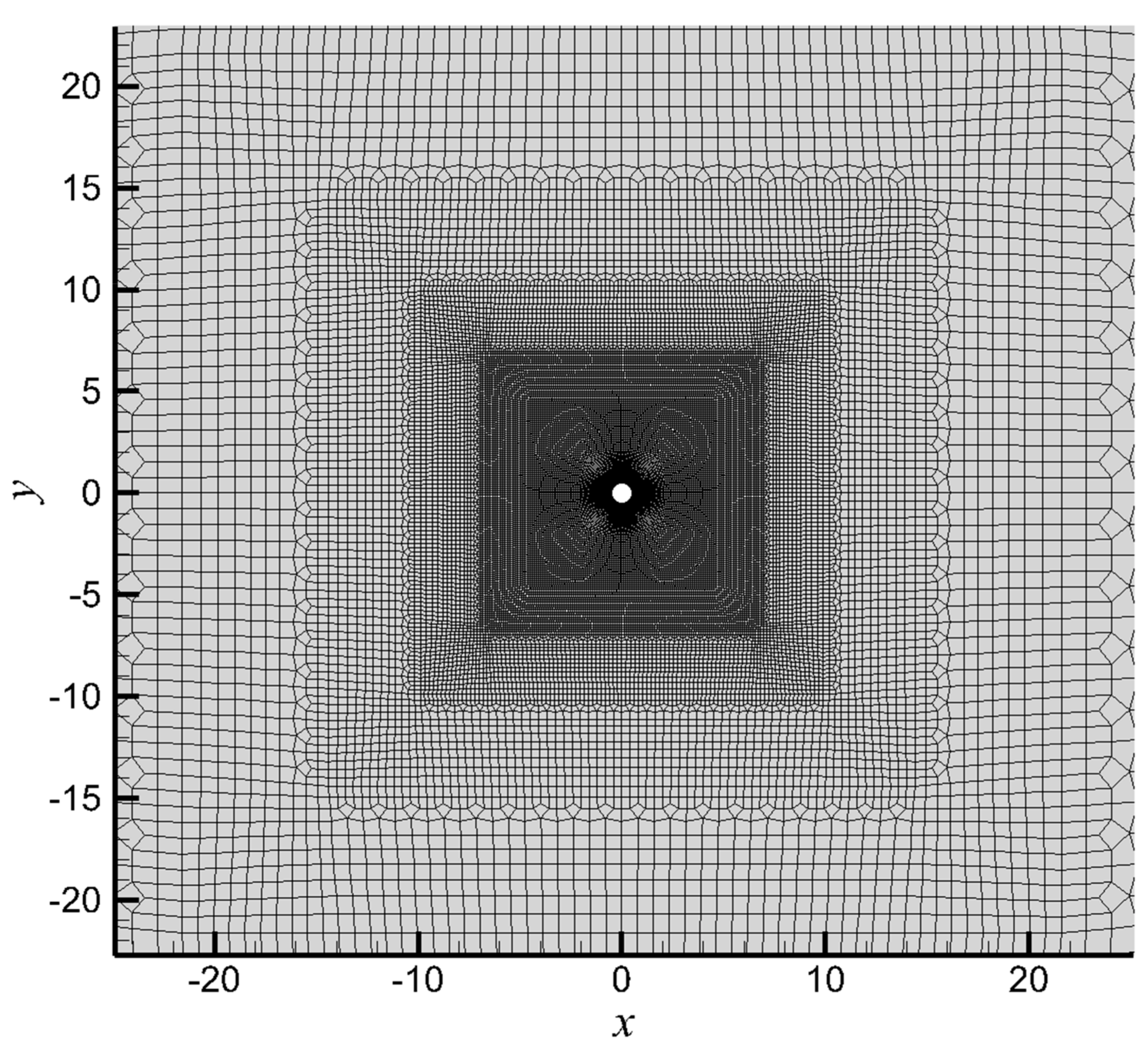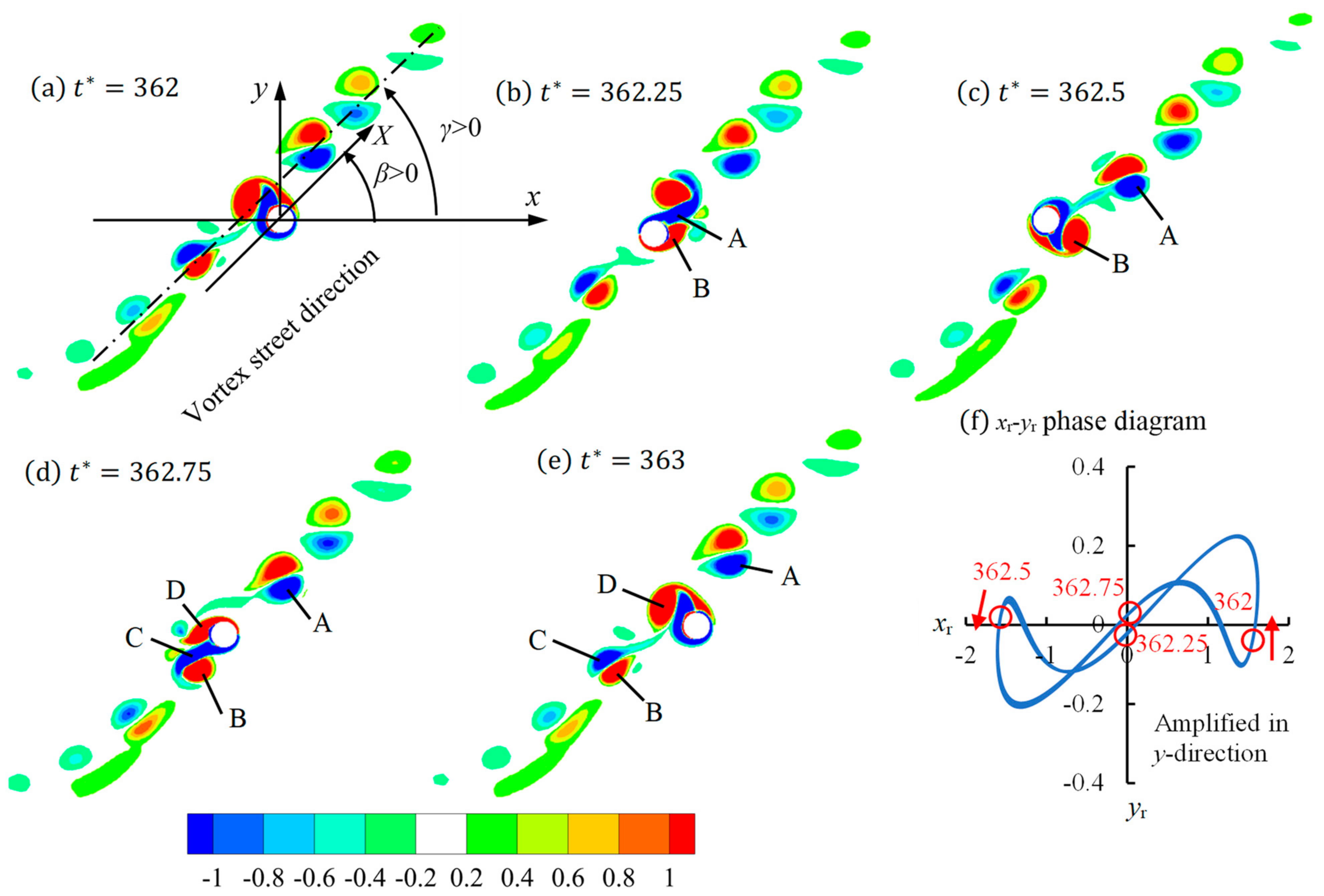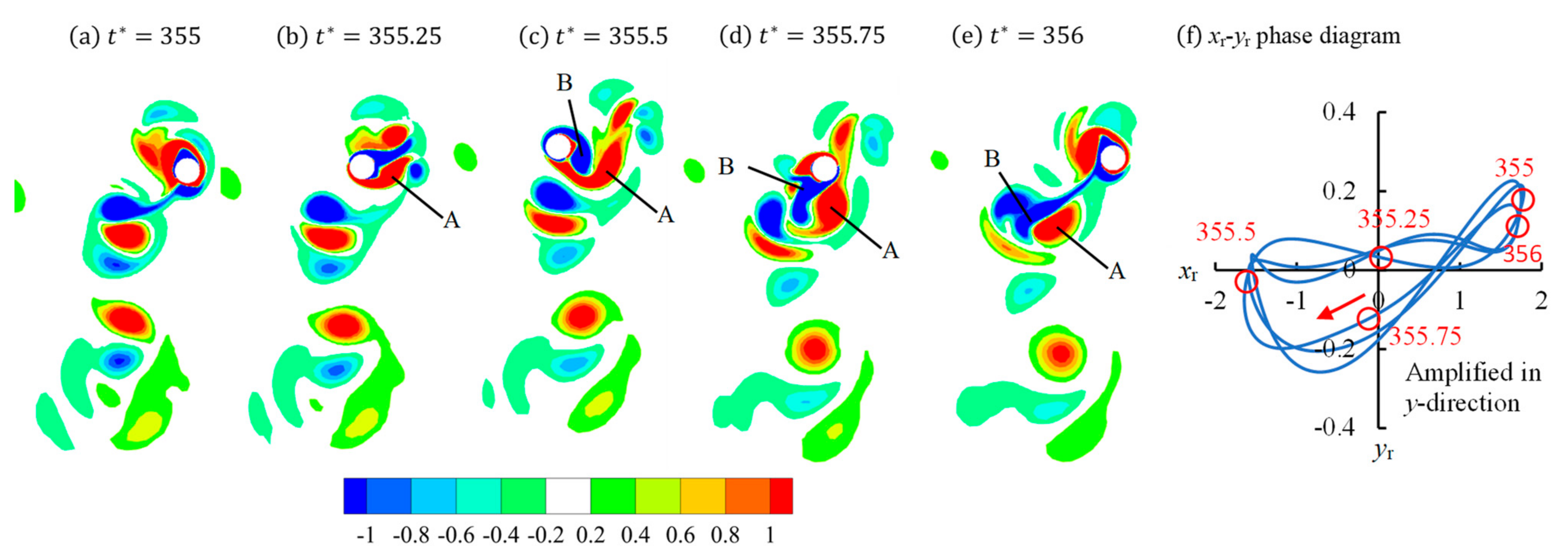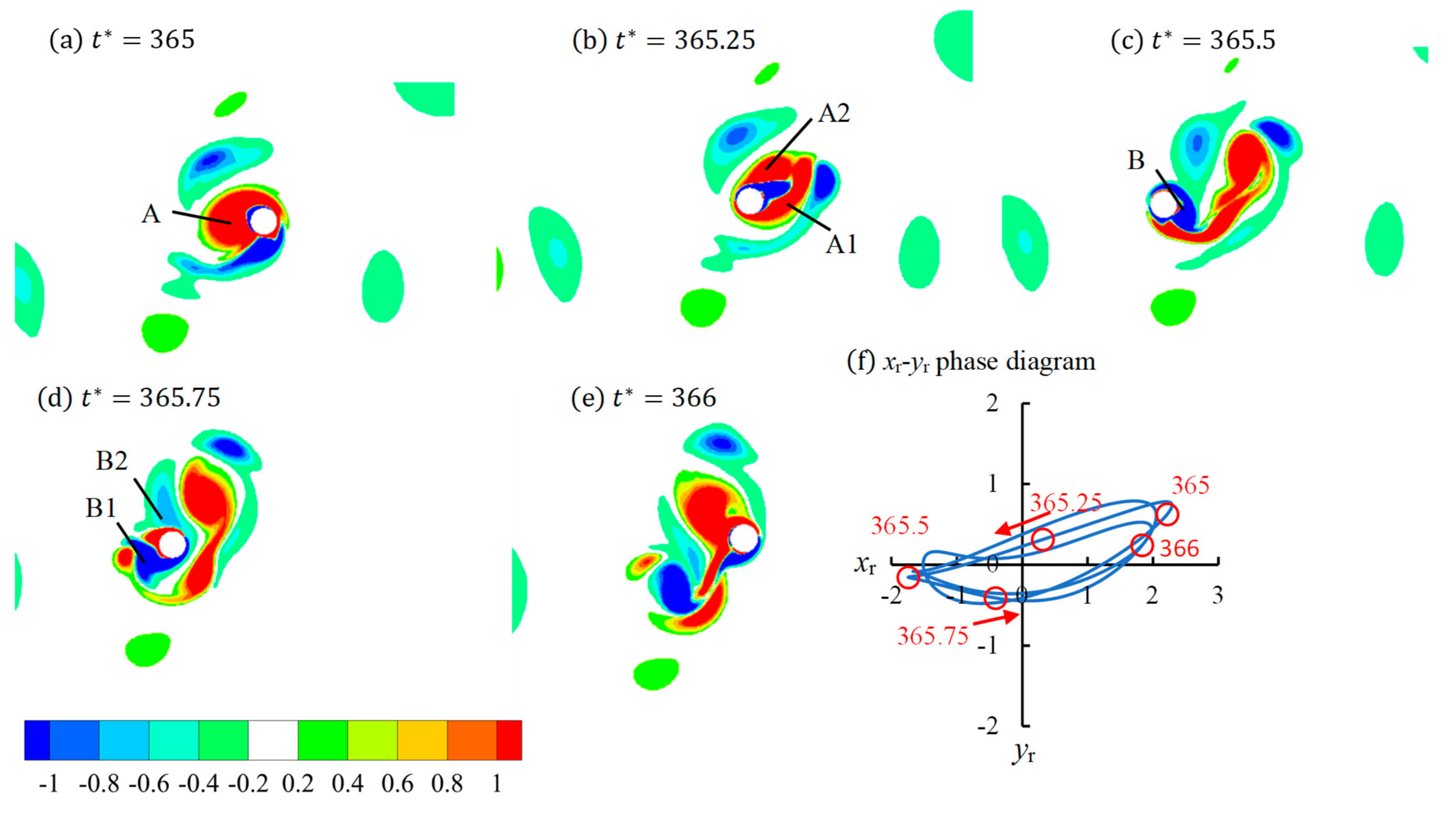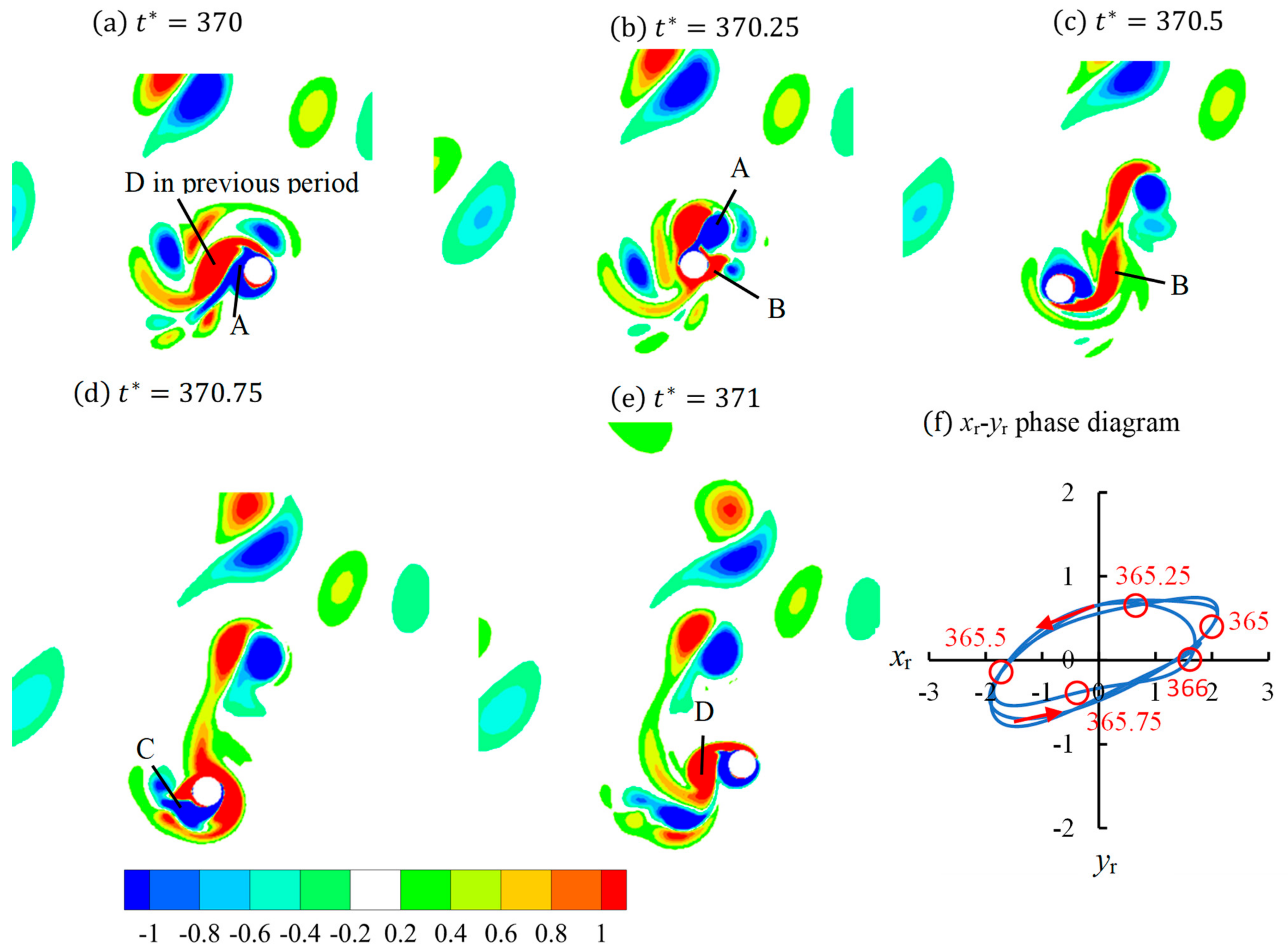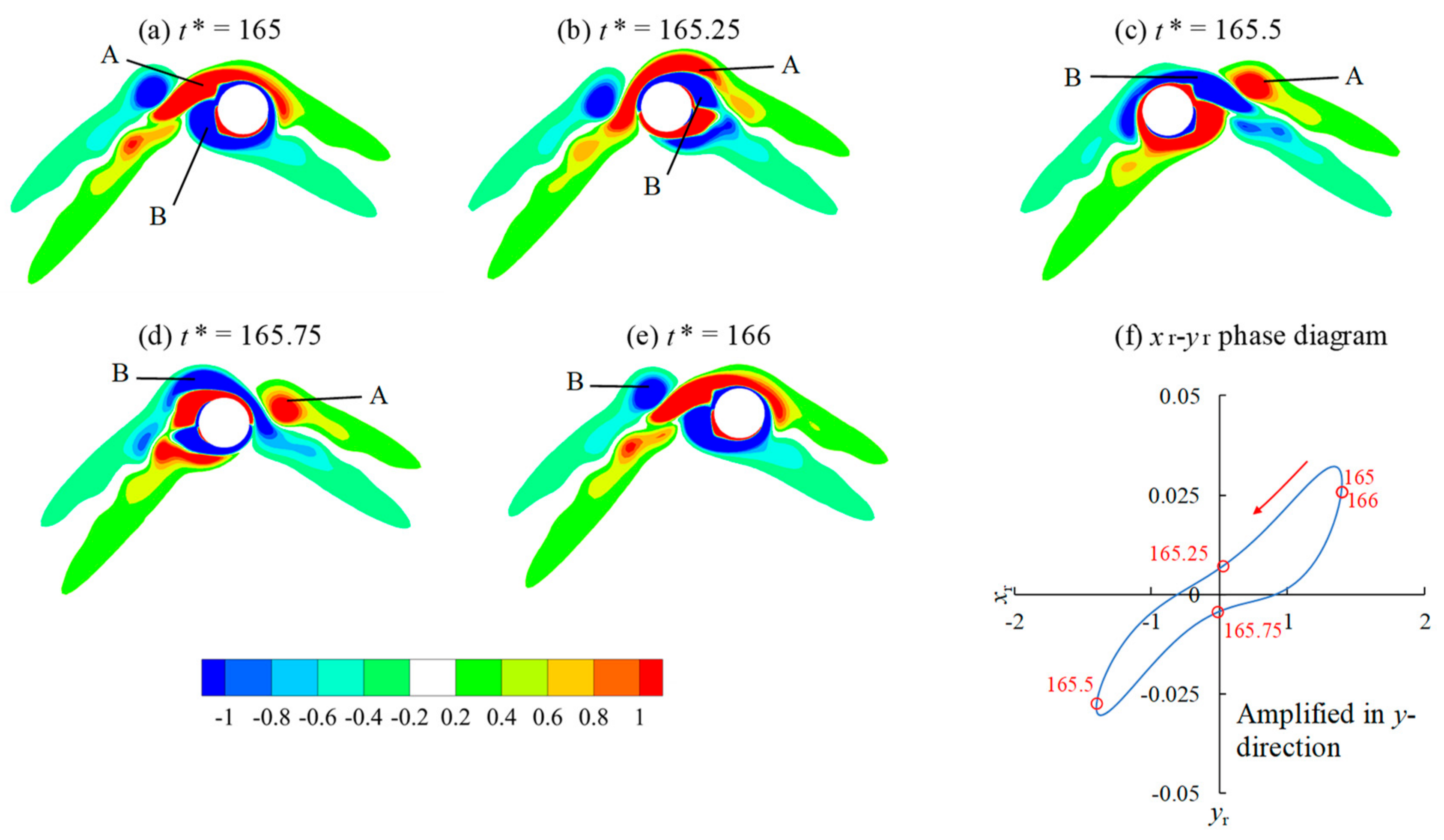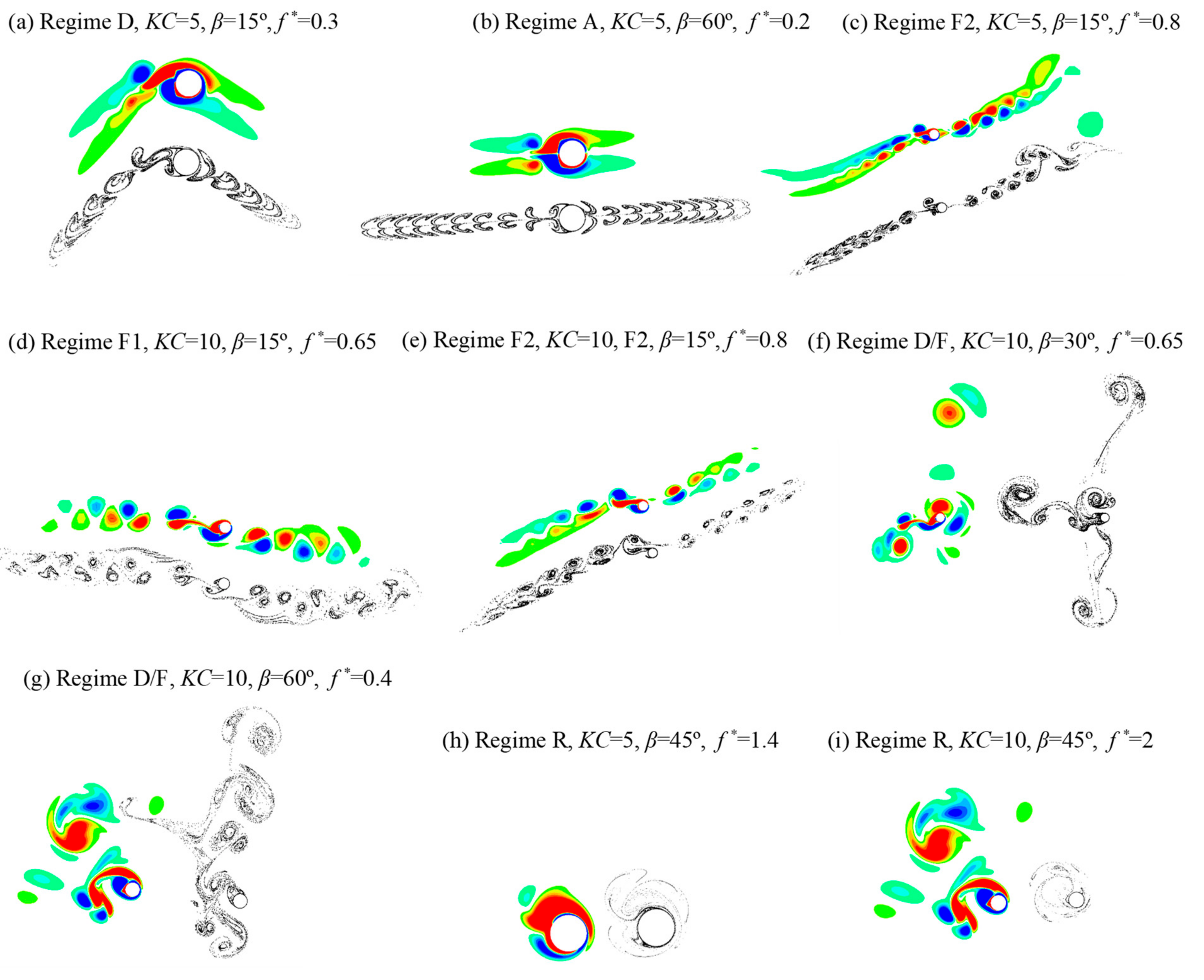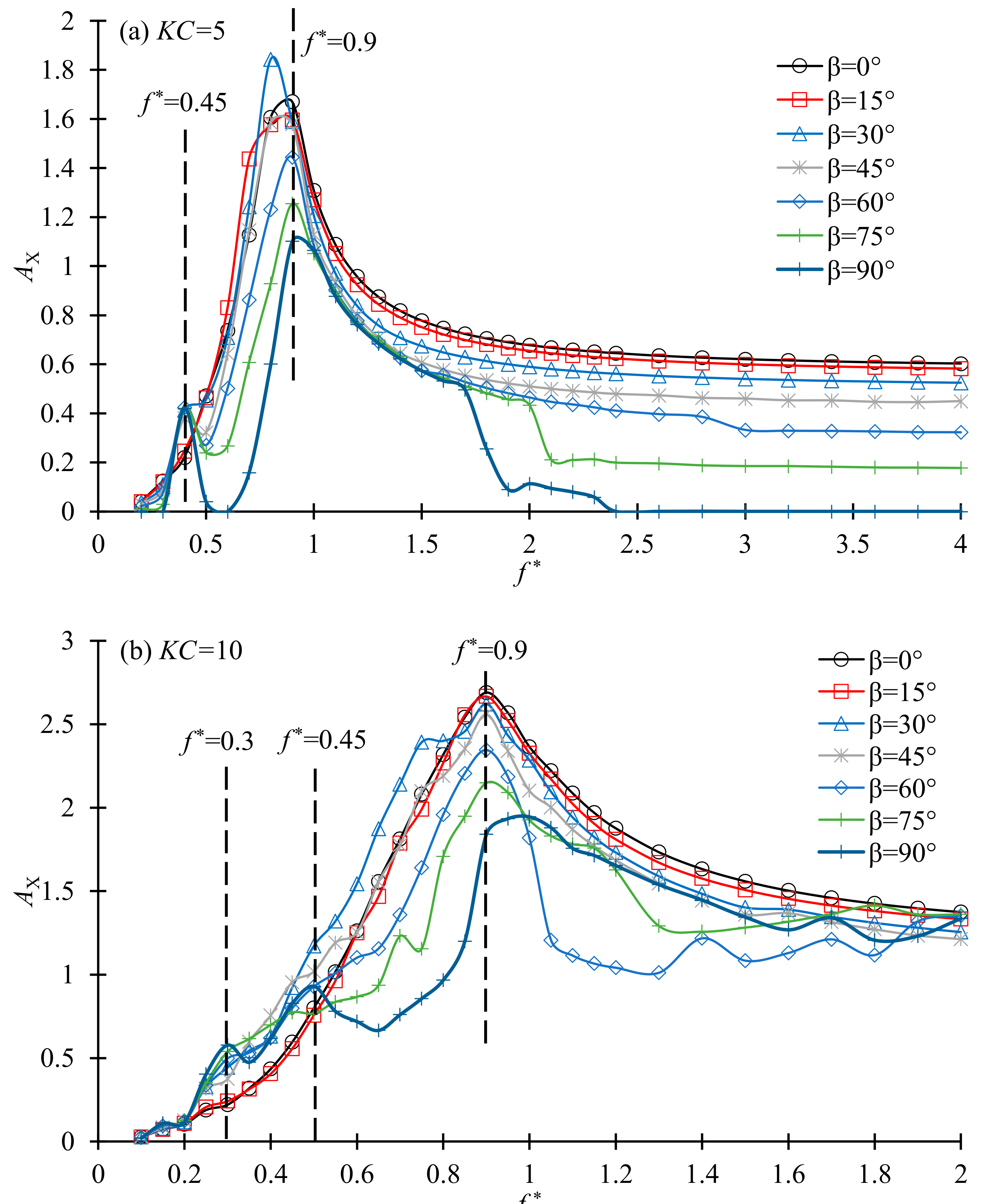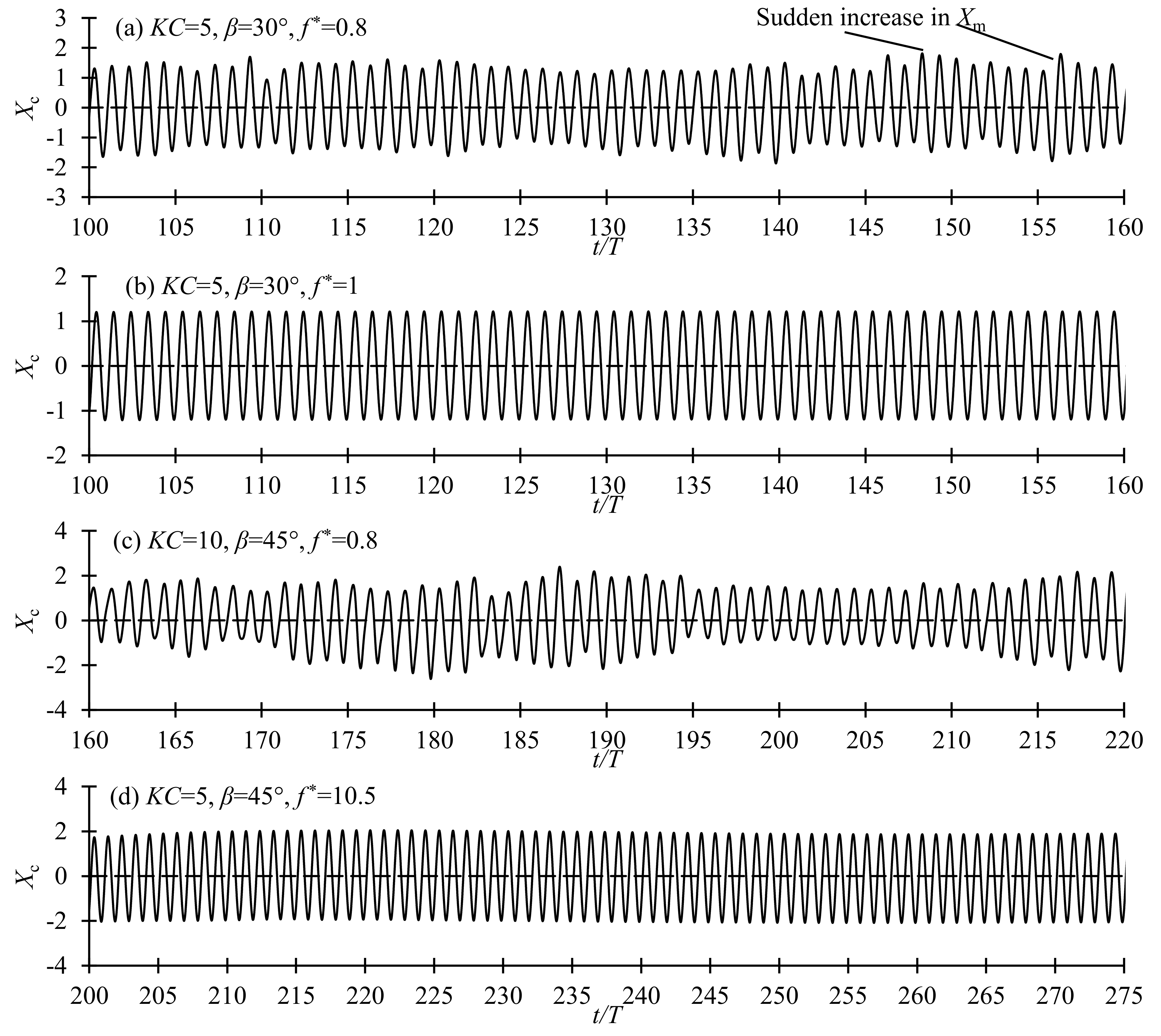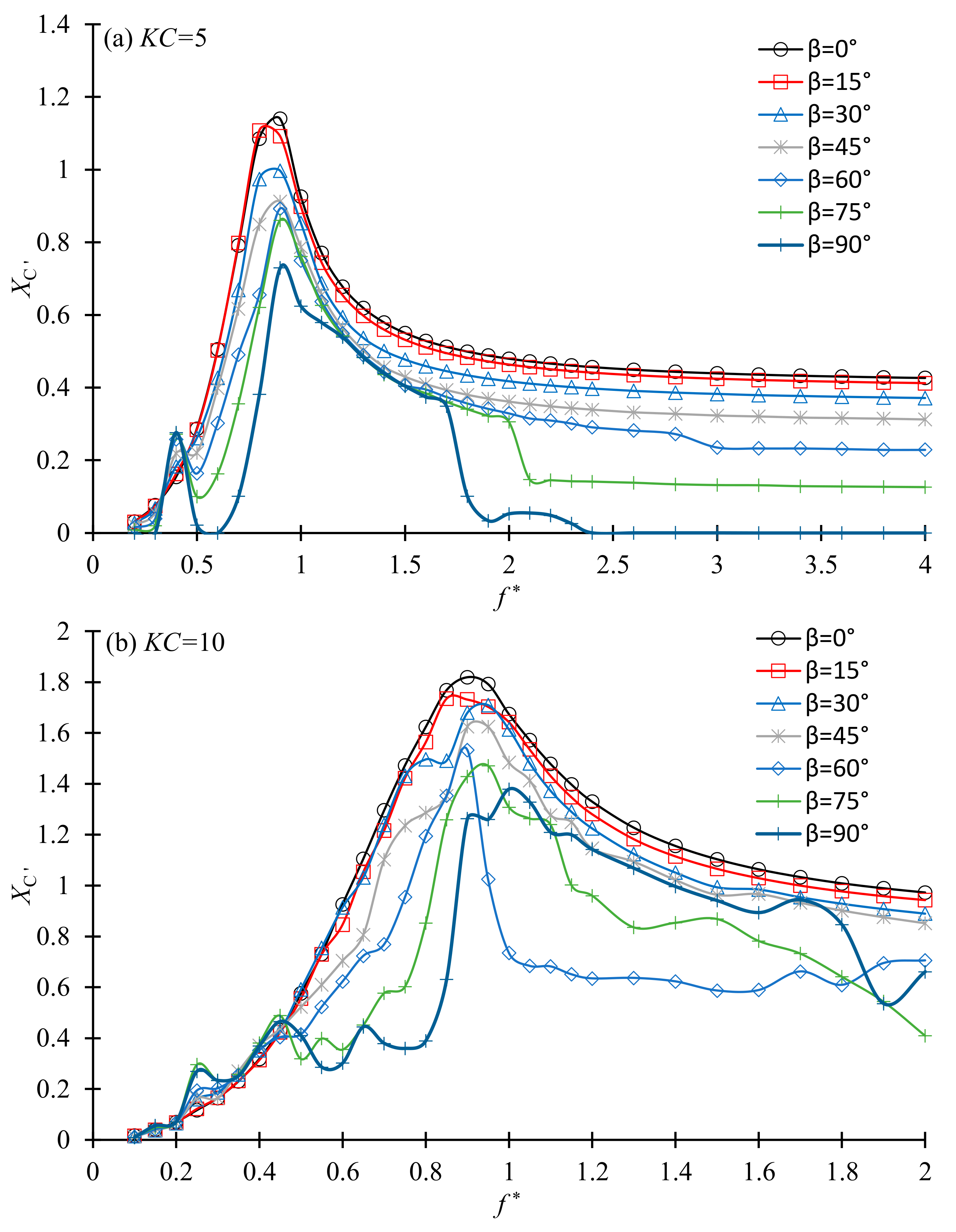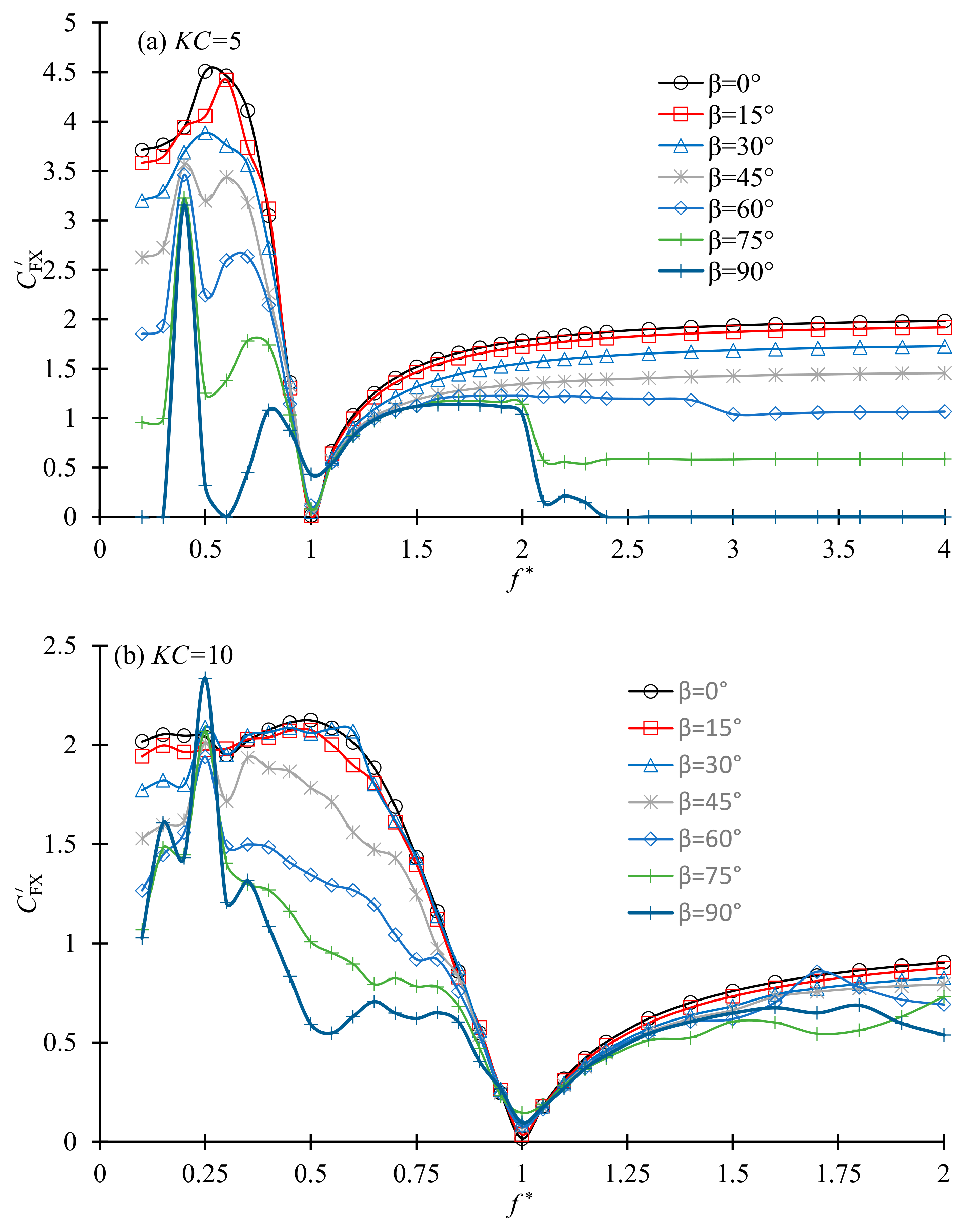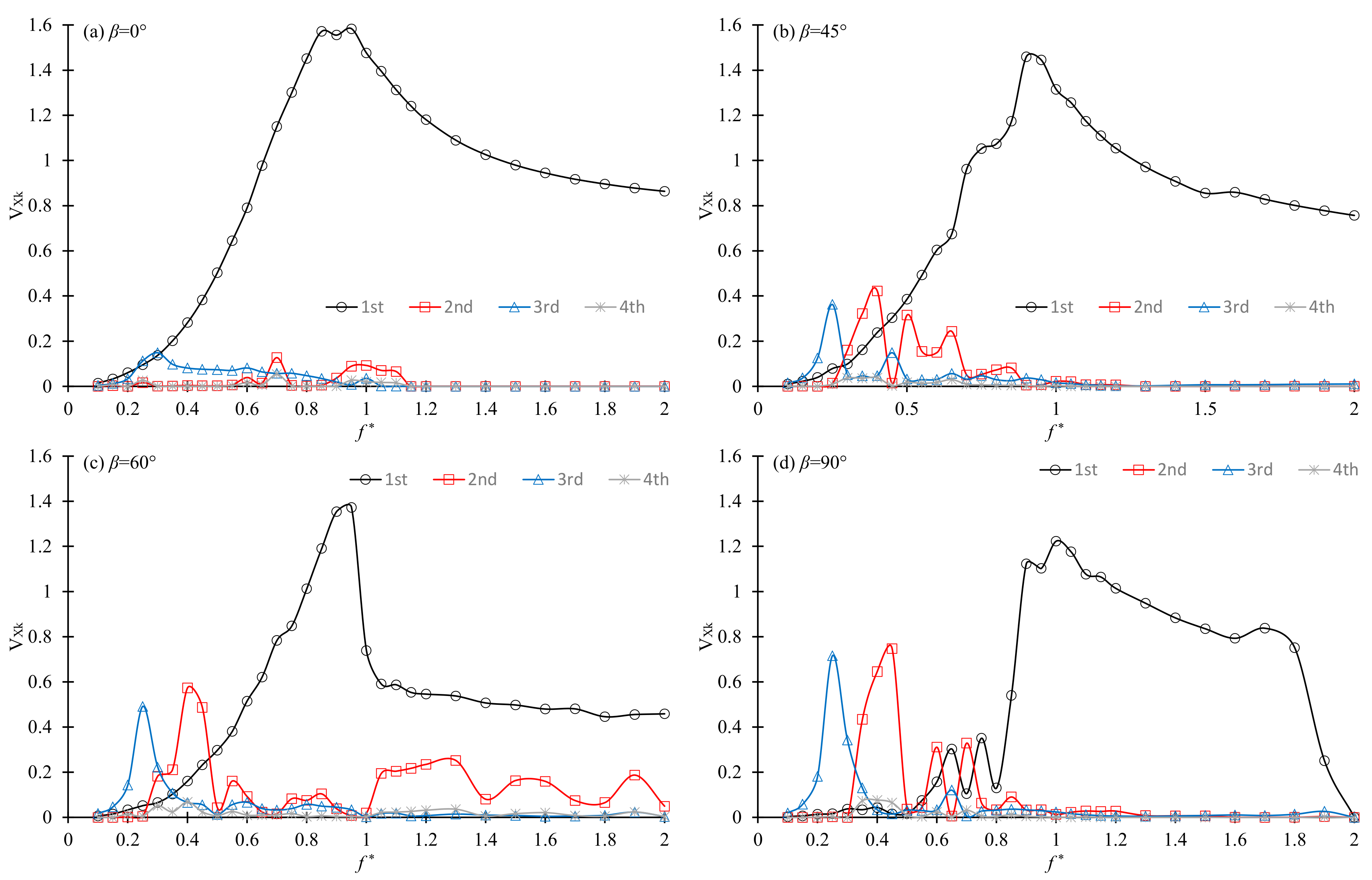Flow Regimes
If the cylinder is stationary, the flows for a constant Re = 150 and various
KC numbers can be classified into Regimes A/A*, D, F [
12,
15]. No vortices are generated or shed from the cylinder in Regime A*. In Regime A, two vortices form and are separated from the cylinder because of the flow reversal in each half cycle. Regime D has a pair of vortices that shed from one side of the cylinder in one cycle, forming an asymmetric flow pattern. In Regime F, two pairs of vortices are shed from the cylinder in one period of flow. If the cylinder can vibrate in the streamwise direction only at a constant
KC = 10, the relative velocity of the fluid to the oscillatory cylinder changes with the change of frequency ratio. As a result, the above-mentioned flow regimes exist at a constant
KC = 10 and various frequency ratios because flows at different frequency ratios have different effective
KC numbers [
22]. The frequency ratio is defined as the ratio of the oscillatory flow frequency to the natural frequency of the cylinder measured in a vacuum. When the cylinder oscillates diagonally in an oscillatory flow, we find three additional flow regimes: F1, F2 and R.
This section is arranged as follows. First, all the flow regimes for
KC = 5 and 10 are mapped on the
plane in
Figure 3a,b, respectively. Then, detailed flow visualization of every flow regime mapped on
Figure 3 is discussed. Simulations were conducted for
β values ranging from 0° to 90° with an interval of 15° and the values of
ranging from 0 to 4 with an interval of 0.25. As a result, the resolution of the boundaries between regimes is 15° in
β and 0.25 in
. Because the flow near most of the boundaries between the regimes on the map is unstable and aperiodic, we did not further refine the resolution of the boundaries.
In
Figure 3,
KC = 10 and
β = 45° have all the flow regimes except A/A*. This combination of
KC and
β are used as an example to explain all the flow regimes.
Figure 4a–e uses contours of vorticity to show the flow patterns of Regime F1 for
KC = 10,
within one flow period. A vortex street alignment angle,
γ, is defined as the angle between the vortex street direction and the positive
x direction, as indicated in
Figure 4a. The vortex street angle
γ follows the anticlockwise direction. In regime F1, the vortex street direction angle is negative, i.e., opposite to the vibration direction angle. The flow regime F was found when the cylinder is stationary or vibrates in the streamwise direction (
β = 0°). The regime F flow pattern at
β = 0° is the same as the one shown in
Figure 4, but the vortex street angle could be either positive or negative because of the symmetry of the configuration. In regime F1, two pairs of vortices (labeled as A to D in
Figure 4) are shed from the cylinder in one period of flow and they are on two sides of the cylinders, respectively, forming a two-branch vortex street. After vortices B and D are shed from the cylinder before the flow reverses at
t = 365.5 and 366, respectively, they are moved to another side of the cylinder by the reversed flow, while vortices A and C remain on the side of the cylinder where they are shed.
Figure 4f shows the relative displacement of the cylinder to the fluid. The nondimensional relative displacements in the
x- and
y-directions are defined as
and
, where
and
are the nondimensional displacement of fluid particles calculated by
and
, respectively. The vortex flow pattern in
Figure 4 is the same as Regime F in the stationary cylinder because the relative displacement
is negligibly smaller than
, i.e., the cylinder vibrates nearly in the
x-direction only relative to the fluid.
At
KC = 10, Regime F1 occurs at very small frequency ratios for
or
, as shown in
Figure 3. It does not occur at
KC = 5. Increasing
further for
KC = 10 makes the flow change from F1 to F2 regime as shown in
Figure 3b. The F2 regime is a variant of Regime F where the vortex street angle and the vibration direction angle are in the same direction as shown in
Figure 5. Regimes F1 and F2 have the same flow patterns but different directions of vortex street alignment angle
γ. In Regime F2, the first vortex A, which is shed in one oscillatory flow period, is a negative vortex from the top side of the cylinder, instead of a positive vortex from the top side, like in Regime F1. This difference in the vortex shedding sequence between Regimes F1 and F2 results in the difference in the direction of the vortex street angle. We conducted tests to find out if the flow is bistable or hysteresis, or dependent on the initial condition. In the test, we used the stabilized solution of Regime F1 at
as the initial condition, changed the natural frequency of the cylinder to make
and continued simulating the flow and found the flow developed to F2. We did the reverse test by using the stabilized flow pattern of F2 as the initial condition to simulate the case of F1, and the flow developed to F1. The above tests demonstrate Regime F1 and F2 are stable and they do not switch from one to another. We did the same test for other vibration direction angles and did not find F1–F2 bistable. Compared with Regime F1, the oscillation amplitude of
is increased from 0.09 to 0.22 but is still much smaller than the amplitude of
. In addition, the phase between
and
of Regime F2 is different from Regime F1. For example, the directions of changing
at maximum and minimum
positions in
Figure 4f are opposite to those in
Figure 5f.
Figure 6 shows an example of Regime D, where a pair of vortices are shed from only one side of the cylinder in one period of flow and the flow pattern in this regime is also called a transverse vortex street [
38]. Vortices A and B are shed from the cylinder within one flow period in
Figure 6. All the vortices that are shed from the cylinder are located on the bottom side of the cylinder, forming a vortex street that is perpendicular to the flow direction. The vortices in
Figure 6 are aligned in one vortex street and they dissipate much slower than the Regime D of a stationary cylinder [
15].
By comparing
Figure 4,
Figure 5 and
Figure 6, one can see that if Regime D, Regime F1 or F2 forms is determined by the behavior of the second shed vortex B within one period of flow. In regime F1 (see
Figure 4c), the negative vortex B is fully cut off from the top side of the cylinder by the newly generated vortex C before the flow reverses. In the next half cycle, it moves towards the left on top of vortex C. The behavior of vortex B in regime F2 is the same only as vortex B in regime F1, but instead it is a negative vortex. In Regime D, the second vortex B in
Figure 6 was generated but not shed from the cylinder. After vortex B in
Figure 6c is generated from the top side of the cylinder, it moves along the cylinder surface from the top to the bottom side, instead of remaining on the top side, and it becomes the vortex that is shed from the second flow period.
In Regimes F1, F2 and D, the second vortex in each half-period (i.e., vortex B) remains integral and moves along the cylinder surface, regardless of how it moves after the flow reverses. However, for some values of
, vortices clash with the cylinder every time after the flow reverses, resulting in an irregular vortex regime, which sometimes resembles Regime F and sometimes Regime D. This regime is defined as Regime D/F and some examples of this regime are shown in
Figure 7 and
Figure 8. In
Figure 7, vortex A clashes with the cylinder after
and is cut into two halves A1 and A2 by the cylinder at
and vortex B is cut into a stronger B1 and a weaker B2 at
. If vortex A and B had not clashed with the cylinder moving into A1 and B1 positions, respectively, both A and B would have been shed from the bottom side of cylinder and formed a D regime. If vortex A and B had not clashed with the cylinder and moved to A2 and B2 positions, respectively, both A and B would have been shed from the top side of cylinder and formed an F regime. Another example of Regime D/F is in
Figure 8 where the vorticity contours for
=0.6 are shown. The vortex shedding pattern in
Figure 8 resemble Regime F2, but in a very irregular shape. Vortices A and B are shed from the cylinder in the first half-period and vortices C and D are shed from the cylinder in the second half-period. The number of vortices that are shed from the cylinder in half-period is the same as the one in
Figure 5 for Regime F2, but the vortices are not regularly arranged.
Regime D/F only occurs at
KC = 10 and it occupies a greater area than Regimes D or F in the regime map in
Figure 3. The flow is found to transition between Regimes D and F frequently in Regime D/F and the transition can be explained by the phase change of vortex shedding from period to period. Taking
Figure 8 as an example, vortex D at
t* = 371 in
Figure 8e is weaker than vortex D in the previous period (
Figure 8a). In the transition Regime D/F, the last vortex that is shed from the cylinder at the end of period is found to either grow or shrink after each period. The growing and shrinking of a vortex at end of period could causes the flow transitioning from Regime D to F and F to D, respectively.
Regime R occupies the largest area in the regime map for both
KC=5 and 10 in
Figure 3.
Figure 9 and
Figure 10 show examples of Regime R at
and 1, respectively, for
β = 45°,
KC = 10. The typical feature of Regime R is the dominance of one vortex (vortex A in
Figure 9 and
Figure 10) that circles around the cylinder and never dissipates. This dominant vortex gains vorticity to maintain its existence by rotating around the cylinder. In
Figure 9 and
Figure 10, negative vortices can form and be shed on the part of the cylinder surface that is not covered by positive shear layers. For example, in
Figure 9a, the bottom side of the cylinder is not covered by positive shear layers. Vortex B is generated at this time and after the flow reverses. At
= 0.9, negative vortices B and C are generated and only vortex C is shed from the cylinder in one oscillatory flow period. As
is increased to 10, both small vortices B and C are shed from the cylinder, but they are very weak and dissipate quickly. Regime R, which has not been reported in any previous studies, only occurs when the cylinder vibrates either diagonally or in the crossflow direction. It does not exist when the cylinder vibrates in the inline direction [
22]. The
-
phase diagrams in
Figure 9f and
Figure 10f show oval shape
-
trajectories with good repeatability. The relative circling motion of the cylinder with oval shape
-
trajectories continuously feed vorticity into the dominant vortex A such that it never dissipates, as seen in
Figure 9 and
Figure 10. The circling relative motion also allows vortex A to move along the surface of the cylinder and never clash with the cylinder and break down.
The flow regimes are correlated to the number of vortices that are shed from the cylinder in one period of flow. After vortices are shed from the cylinder, the interaction between them and the aperiodicity of the flow may make the flow pattern different than the classic Regime D for a stationary cylinder. For example, the regime D shown in
Figure 6 is very different from the classic Regime D, while the Regime D at
KC = 5 shown in
Figure 11 is ideally periodic and very similar to the Regime D flow pattern of a stationary cylinder. The Regime D at
KC = 5 in
Figure 11 is very similar to Regime D for a stationary cylinder because the relative displacement
yr in the crossflow direction is negligibly smaller than
xr, making the cylinder experience a relative flow purely in one direction. In regime D/F, the well-defined, classic Regime D or Regime F pattern cannot be identified as in
Figure 7 and
Figure 8.
The vortex shedding regimes are further visualized by the streak lines together with the vorticity contours in
Figure 12. Vorticity dissipates quickly in Regimes A and D, but the vortex streets can be identified using streak lines in
Figure 12a,b. Regime D is a regime where vortices are only shed from one side of the cylinder, while Regime A is the regime where vortex shedding does not occur and the streak lines are in the form of two streams of particles going away from the cylinder from two opposite sides of the cylinder. Because the cylinder oscillates diagonally with a small amplitude, the vortex street in
Figure 12b is slightly tilted. In Regime A, the vibration amplitude in the crossflow direction is very small, and as a result, the vortex pattern is similar to flow past a stationary cylinder at small
KC number, as shown in
Figure 12b. In Regimes F1 and F2, strong vortices are shed from the cylinder, and as a result, the two vortex streets identified by the vorticity contours are in the same pattern as the streak lines, as seen in
Figure 12c–e. In Regime D/F, vortex shedding flow is aperiodic and the streak lines are in a pattern where fluid particles move away from the cylinder in three directions in
Figure 12g and two directions in
Figure 12 h. Because the vortex shedding pattern resembles Regime F sometimes and resembles Regime D sometimes, the pattern of the streak lines does not remain the same pattern. In regime R, the circulation of the vortices around the cylinder makes it difficult for the fluid particle to move away from the cylinder. The streak lines of Regime R are in a pattern where water particles also circle around the cylinder, as shown in
Figure 12h,i.
Figure 13 shows the variation of the vibration amplitude with the frequency ratio for
KC = 5 and 10. The vibration amplitude is defined as
, where
is the maximum displacement within one period. The maximum vibration amplitude within the last 100 periods is shown in
Figure 13. The vibration amplitude is found to peak at about
f * = 0.9 for all the values of
β and both
KC numbers. It peaks at a natural frequency ratio slightly smaller than 1 instead of 1 because of the effect of the added mass of the fluid. The peak value of
Xm reduces with the increase of
β, except
β = 30° and 15° for
KC = 5 and 10, respectively. The time histories of the vibration shown in
Figure 14 explain why the maximum vibration amplitude at
β = 30° and 15° are higher than those of
β = 0°. In
Figure 14a, the vibration is irregular and occasionally vibration amplitude increases suddenly in one or two periods as indicated. Aperiodic force and vibration of cylinders in oscillatory flow at boundaries between flow regimes were also reported [
15,
39]. The occasional increase of the local
Xm causes the abnormal increase in the
Xm in
Figure 13. In
Figure 14c, the vibration is also irregular and
Xm does not remain constant. The vibration time history becomes strongly aperiodic when the vibration is in Regime D/F and periodic when the vibration is in other regimes. The standard deviation of the vibration (
) shown in
Figure 15 is obtained using 100 periods of data.
is proportional to averaged amplitude of the vibration of all the 100 periods. It can be seen in
Figure 15 that, generally,
follows the same trend of
Xm and the peak value of
decreases with the decrease in
β.
Figure 16 shows the variation of the standard deviation (SD) of the nondimensional force in the vibration direction of the cylinder with the natural frequency ratio. The nondimensional force is defined as
, where
FX is the dimensional force and the standard deviation (SD) of
is represented as
. The variation of
Xm with
in
Figure 13 does not follow the trend of
because the frequency of the force plays a significant role in the vibration also, in addition to the magnitude of the force. The nondimensional force in the vibration direction reaches its minimum value at
= 1 for both
KC numbers. The sudden jump of the phase between the force and velocity in the
x-direction can be seen in
Figure 17. When
β is close to 90°, a maximum value of
occurs at
slightly smaller than 0.5 for
KC = 5 and
0.25 for
KC = 10. Because the damping ratio is 0 in this study, there is not any net energy transferring between the fluid and the cylinder. This is the reason why the phase between the vibration velocity and the force is either −90° or 90°. The phase
ε changes from −90° to 90° as
exceeds 1 for all the vibration direction angles in
Figure 17. Because the vibration amplitude in
Figure 13 and the SD of force in
Figure 17 are not correlated with each other, the degree of vibration cannot be purely estimated based on the magnitude of force.
To understand the frequency component of the vibration, the nondimensional velocity of the cylinder in the
x-direction is decomposed into harmonics as
, where
VX is the velocity of the cylinder in the
x-direction,
VXk is the amplitude of the
k-th harmonic and
φk is the phase of
k-th harmonic.
Figure 18 shows the variation of the first to fourth harmonics of the velocity of the cylinder with the frequency ratio for
KC = 10. The contributions of the harmonics to the cylinder velocity are significantly affected by the vibration direction angle
β. At
β = 0°,
VX is dominated by the first harmonic, as shown in
Figure 18a, except
. Although third harmonic is comparable with at
< 0.3, it does not excite strong vibration because its frequency is far different from the natural frequency. The contributions of the second and third harmonics increase and the contribution of the first harmonic decreases with the increase in
β, especially at small values of
. At
β = 60°, the dominance of second and third harmonics over the first harmonic can be clearly seen in the range of
< 0.5 in
Figure 18c. At
β = 90° the contribution of the first harmonic is negligibly smaller than the second and third harmonics in the range of
< 0.5. The local maximum values near
= 0.3 and 0.45 at
β = 90° in
Figure 13 are caused by the strong contributions of the second and third harmonics. At small values of
β, the secondary local peaks in the vibration amplitude do not exist because the contributions of higher harmonics are too small to excite high amplitude vibration at high frequencies. Comparing
Figure 16b with
Figure 18 it can be seen that the force in the
X-direction reaches its maximum at the
values where the second harmonic of the
VX peaks.
The dominance of higher-order harmonic forces at
β = 45° to 90° and smaller frequency ratios can be explained by the flow patterns. At large values of
β, the vibration is dominated by the fluid force in the crossflow direction. The fluid force in the crossflow direction is large when vortex shedding is strongly asymmetric, and its frequency is affected by the vortex shedding. From the regime map in
Figure 10, the vortex shedding is dominated by Regime F or D/F as
is less than 0.7. One and two pairs of vortices are shed from the cylinder within one period of flow in regime D and F, respectively. Considering the effect from the flow reversal, the frequency of the lift coefficient is twice or three-times the oscillatory flow frequency in Regimes D and F (one and two pairs vortex shedding in one period), respectively [
21,
40]. The higher-order lift coefficient in Regimes D and F are the reason for the higher-order vibration at small values of
and
β = 45° to 90°. The fluid force in the streamwise direction is dominated by the inertial force that is proportional to the acceleration with the frequency that is the same as the oscillatory flow frequency. That is the reason why the vibration in the streamwise direction is dominated by the first harmonic at
β = 0°.
